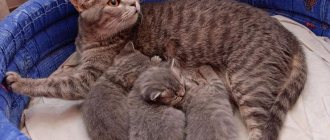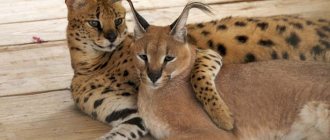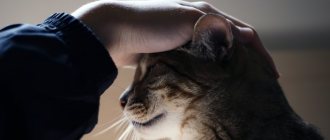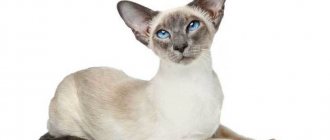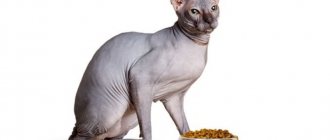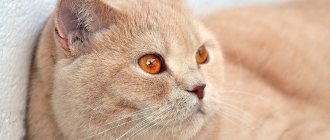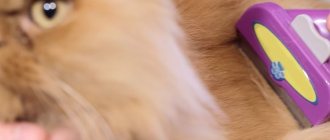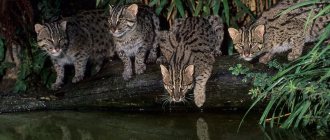The dream of many children is to have their own pet, and often a cat. Cats often serve an important role for children: they provide constant contact, keep secrets, and listen. The purring is soothing, and watching the animal play is a pleasure.
In preschool age, children learn better how to carefully and properly handle pets. At this age, children can help care for the cat under the supervision of their parents. However, of course, we must not forget that each animal has its own character, likes and dislikes. Consider below which cat breeds are still suitable for children.
American Curl Shorthair
"Curl" means "wrinkled" and this leads to the characteristic feature of this cat breed - its ears curled back. This feature arose as a result of a random mutation and was specially bred.
This is a family cat par excellence due to its pronounced good nature. She is gentle and forgiving towards small children. With older children she enjoys more daring games. A little wary of strangers. She enjoys cuddling with her owners, although she usually has a main reference.
The American Curl Shorthair also gets along very well with other pets, whether they are other cats or dogs. The cat is a very sociable cat who definitely doesn't want to be left alone. Despite their balanced, rather calm character, cats of this breed need a lot of exercise.
The noticeably curled ears are a trademark. Depending on the degree of inclination, they are more or less bent back. The coat is short, smooth and silky, with almost no undercoat. All colors are allowed. Females weigh up to 7 kg, males - up to 12.
Outbred
It is unknown what character traits a cat adopted from the street or from a shelter has. She may turn out to be a playful fidget, a calm aristocrat, or a feisty one.
However, most often, street kittens quickly become attached to a person and accept the rules of behavior in the apartment.
Such cats are not very sociable - this is fixed at the genetic level. But the former homeless animal is self-sufficient, not annoying and unobtrusive. At the same time, an even, warm relationship is built with children, but the kitten is unlikely to allow itself to be commanded.
After adopting an animal from the street, owners need to do a full veterinary examination.
Bombay
Bombay was created in the USA in 1958. In the late 1950s, American breeders wanted a cat that had the texture and appearance of the Burmese, but also had a deep, glossy black color. This breed would resemble the Indian black leopard. To this end, a breeding program began for the Burmese and the black American Shorthair cat with light copper eyes. The resulting cat was named Bombay after the black leopard, which she actually resembles. Bombay was recognized as a "show cat" in the late 1970s. Although Bombays are still not common, they attract the attention of the public at any exhibition in which they are presented.
The Bombay impresses with its elegant appearance and shiny coat. Despite its bright appearance, this breed is not wild or arrogant; on the contrary, it is very pleasant and peaceful.
Bombay is quite intelligent and, due to his high intelligence, especially enjoys more demanding games, which should never become fast paced. Because she needs a lot of rest and a refuge in which she can retire if necessary. However, in most cases, the cat wants to be noticed by its owners, sometimes they demand this quite annoyingly.
Smart Bombay is trained to walk on a leash and is one of those jokingly called "dog cats." The cat does not require special care, but to keep its coat shiny, it should be brushed several times a week.
The most striking thing about Bombay is his black, silky coat. The build is petite but athletic. Females weigh on average 4 kg, and males - 5 kg. Black fur is dominant, but sable kittens are sometimes born, and some associations allow these kittens to be registered as Burmese. The Bombay's eye color ranges from gold to copper.
Turkish Angora
The noble Angora celebrated success as one of the oldest cat breeds of the Ottoman Empire. It was recognized as a breed back in the 15th century. Angora" is the old name of Ankara. For a long time, the Angora cat was understood as all cats with long hair, mostly white. The term is still used today outside of specialist circles and is sometimes used colloquially as a synonym for Turkish Angora.
This breed arose without human intervention. She is distinguished by her special loyalty, which is often compared to dogs. Because she follows her guardian every step of the way. Most of the time she hopes to be petted, as she needs a lot of love and pleasant sensations. The Turkish Angora is usually an easy-going personality that gets along well with everyone: with its relatives and other pets such as dogs, and, of course, with its owners.
This breed is an excellent playmate for children. Because their joy from playing practically knows no bounds and hardly diminishes with age. The cat also likes to fetch smaller toys, which regularly excites children. She attracts attention by purring and stroking her legs. If a cat feels neglected, it may become withdrawn. In addition to careful care, she also needs a lot of space to be able to live to her satisfaction. The cat has semi-long, silky fur that fits tightly to the body because it has no undercoat. The colors are white, black and red with different shades. The body is long and slender, at the same time muscular, although the cat looks fragile. Even male cats hardly exceed 4 kg.
What selection criteria should you focus on?
The choice of sex of a four-legged pet is influenced by many factors. One of the most important criteria is the type of home in which the owner lives. We must not forget about those who live next to him. The presence of small children and other pets must be taken into account. An important factor will be how the new pet tolerates loneliness and long separation from a loved one.
In an apartment or private house
When thinking about whether it is better to have a cat in an apartment or a country house, you can read forums or chat with experienced owners. Most often, in a city apartment it is recommended to have cats. Females are cleaner than males, do not leave odorous marks, and do not scatter litter. In addition, keeping a girl in a confined space will not result in an unplanned pregnancy, because the owner can control her social circle.
Cats love to spend time on the couch and on a person's lap. They don't need the open spaces of the street to feel happy. But the female, unlike the males, is much more effective in ridding the country house of annoying rodents. Cats quickly lose interest in monotonous hunting and find other activities - mainly guarding the territory and clashes with neighboring cats.
Boys prefer the opportunity to go outside the home. They want to run, jump, climb trees. Males need to feel like masters, so they mark their territory. Finding such marks in an apartment is not very pleasant. A private house will be the optimal habitat for boys.
Affectionateness
The furry pet is very sensitive to the attitude of family members. If someone doesn’t like him or offends him, the two-legged animal avoids him.
Girls are more prone to reciprocal affection and tenderness from the owner. Kitties become more attached to a person and better adapt to his character. Cats are more independent in this regard. They are more interested in climbing a tree or curtain than purring in the arms of their owner.
Intelligence and ease of education
The behavior of mustaches directly depends on their upbringing
It is important to instill in children the norms of behavior in the family from early childhood. Representatives of any gender and breed respond well to the persistent demands of the owner
However, females are more flexible in this regard. They will fulfill a person’s demands, so as not to offend him, to please him.
Males, on the contrary, will prefer to run away, hide, rather than obey. It is more difficult to train them to use the cat litter box and not to throw litter around. After a walk outside, males will immediately jump onto the sofa, and the girl will patiently allow her to wipe her paws.
Independent representatives of the cat family that do not like to obey humans and are difficult to train include the British, Russian Blue, and Scottish Fold breeds. But sphinxes, bobtails, and orientals are ready to do anything for the sake of their owner, so they can be trained without any problems - regardless of their gender.
Are there small children in the family?
Females are much more obedient and affectionate than males. They are less likely to scratch and bite
In a family with a small child, this is very important. The male is accustomed to dominating and defending his position no matter what, so he is capable of harming the baby
You must understand that no animal likes to have its tail pulled, constantly pressed and squeezed. It is necessary to explain to the child that this is not a toy, but a living creature with its own character. Sooner or later, both girls and boys can react equally aggressively to persistent caresses and disrespectful attitudes.
Are there other animals in the family?
Because of their inherent mentality, girls share their territory with other pets much more easily. And the tendency to dominate, characteristic of boys, forces them to show their superiority over the rest of the inhabitants. It is especially difficult for two cats to get along in one place. They constantly fight for leadership, arrange showdowns, and mark their territory.
Even castrated males are unlikely to make friends - most likely, their conflicts will subside, but a strong friendship will not work out. If there is an adult cat in the house, it is not advisable to take a second adult male - it is better to take a female or a very small kitten.
Cats get along with other animals depending on their character, and gender does not have that much influence on this. Even a brutal cat can become an affectionate nanny for a horde of puppies, ferrets and even chicks - if his disposition is completely peaceful.
Abyssinian
The Abyssinian's roots are in Southeast Asia, and they are one of the most bred cat breeds in the world. It came to Europe in the 19th century and was registered in Germany in 1933. Like many other cat breeds, the Abyssinian's survival was threatened during and after the two world wars.
No matter how many animals live in a farm that provides entertainment, the Abyssinian is very human-oriented. The Abyssinian cat looks at people with curiosity, and especially at children. A smart kitten carefully records every action. Cats love children very much, and boredom and excessive rest are out of the question.
The Abyssinian is slender and finely built, with long legs. Reaches a shoulder height of 40 and a length of 60 cm. Cats weigh from 2.5 to 4 kg, males - from 3.5 to 5 kg. The coat is short and has no pattern in purebred Abyssinians.
The short coat of the Abyssinian does not require special care. It should be brushed from time to time; cats shed in the spring. She needs a lot of attention, movement and variety.
Norwegian forest
The breed has been specially bred only since 1930, Norwegian Forest cats have no hereditary diseases and usually have good health.
However, the athlete cat is extremely active, a gifted climber, and constantly fulfills her desire to move. Throughout her life, she has enjoyed playing outdoors, even in inclement weather.
The beautiful Norwegian is not a cat that needs to be looked after from morning to night. On the contrary, it is economical in care.
The Norwegian Forest Cat is very affectionate with children and enthusiastically spends time with them. Due to its gentle nature, this cat is also suitable for families with small children, to whom it treats with great attention. Because she is straightforward, open-minded and quite tolerant.
The Norwegian Forest Cat is an imposing figure. This is due, on the one hand, to their size (shoulder height 45 cm, females weigh from 3.5 to 7 kg, males from 5 to 9.5), on the other hand, to their half-length body, which is especially thick in the area neck. It consists of a dense undercoat and a long, dense topcoat. The body is strong and athletic.
The Norwegian Forest Cat is easy to care for. She does not need constant outside employment and, as a rule, she is quite thrifty. Because the top coat repels moisture and dirt, your cat only needs to be brushed once a day. In principle, even once a week is enough.
British Shorthair
The British Shorthair originated quite accidentally in 19th century Britain from domestic cats that once arrived on the island with the Romans, and various breeds. The thick fur looks like plush.
The British Shorthair cat is very fixated on people and absolutely demands attention - anywhere and at any time. The shy cat usually gets along well with other animals, especially if they have been socialized from an early age. Despite all its coziness, the powerfully built British Shorthair is also a good hunter who persistently pursues its prey.
The cat is stocky - this is due to thick hair, on the one hand, and a strong physique, on the other. Females weigh from 4 to 6 kg, males - from 7 to 8. Fur colors are very varied, but the ash color is especially popular among breeders and owners.
To overpay or not to overpay?
When purchasing a cat, you may come across different prices, and in different regions they differ significantly, so the question arises, why in some places they give purebred cats for absolutely nothing, and in other places they ask for fabulous money for them? This all depends on several factors:
Each nursery must maintain its own brand. It’s the same as with selling things: branded clothes are much more expensive than similar Chinese products
The nursery will provide you with documents for the kitten, which will indicate its pedigree, and this is very important if you want to reproduce the animal in the future. Of particular value are show-class kittens whose parents took prizes in shows and exhibitions.
If this is not important to you, then you shouldn’t overpay. Compliance with breed standards. Experts will immediately suspect incest in the kitten’s appearance. This is called a defect, a deviation from the breed. Sometimes such defects can occur in a kitten of purebred parents. But still, it is not suitable for exhibitions, unlike its successful brothers and sisters, and therefore its price will be much lower. The age of the kitten also plays a role. It is best to sell it at the age of 2-3 months. Older kittens are considered “grown up” and are cheaper. Sometimes it happens that a kitten is sick, and the owners try to sell it quickly while the disease is not noticeable. In this case, the price may also be low.
Javanese cat tolerates loneliness without owners during the day
There are different cases, for example, at the poultry market, a purebred kitten can be bought for ridiculous prices. Owners sometimes don’t know how to quickly get rid of their offspring. If you are not interested in exhibitions, medals and regalia, then this is also a good option for purchasing a furry miracle. It’s up to you to choose which cat is best to have in your apartment.
Important! If you want a cat to perfectly suit your lifestyle, then it is better to take an animal from breeders. They will tell you which cat is best to have in your apartment and select a pet for you, taking into account your interests
But it’s worth telling about your wishes in more detail so that there are no disappointments later.
They will tell you which cat is best to have in your apartment and select a pet for you, taking into account your interests. But it’s worth talking about your wishes in more detail so that there are no disappointments later.
For example, it is very important to know how long you will be away, since some breeds cannot tolerate loneliness, it is also important whether you have enough time to care for the cat, this is important for long-haired breeds, whether you plan to have offspring, etc.
Ragdoll has an easy character
A good breeder is also interested in ensuring that his kitten ends up in kind and caring hands. It may take time for you to choose the right option, but if your desires and capabilities coincide, you will gain a reliable friend for life.
Siberian
It acquired its current appearance in Russia. It also came to Western Europe in the 80s of the 20th century. In 1998, the International Cat Federation recognized Siberian cats as a separate breed.
Children love them and can play and tinker with them for hours. At the same time, the cat never becomes aggressive and is especially attentive to small children.
Thus, the Siberian cat is a true family cat that gets along well with everyone. However, she usually has a loved one who loves her especially. Despite all the affection, the Siberian cat, like all representatives of natural breeds, is an excellent hunter with a great impulse to move.
The Siberian cat has semi-long, silky hair that comes in different colors and a fluffy tail. The body is quite large and muscular. Females weigh on average 4.5 kg, males 6 kg. The eyes are slightly slanted and come in a variety of colors, especially bright blue. Caring for a Siberian cat is similar to caring for a domestic cat. The Siberian cat needs a lot of exercise and affection.
Manx cat
The homeland of Manx cats is the Isle of Man, located in the Irish Sea. There are several opinions about how tailless cats got there: according to one version, they were brought from the Far East or from China, according to another, from Japan. The medium-sized animal differs from its fellows in the absence of a tail. True, not all representatives of the breed have lost this part of the body: among Manx there are short-tailed representatives and cats with tails of normal length.
A plush ball is what a baby Manx cat looks like. As he grows older, he increasingly takes on the appearance of a representative of the cat breed, but does not lose his roundness in outline.
The Manx's coat is short, fluffy and soft, with a rich undercoat: reminiscent of rabbit fur. The cat is also related to this animal by its method of movement - jumping.
The color of the animal's fur can be any. Large, round, slightly slanted eyes harmonize with the color of the fur. The look, intelligent and expressive, expresses love and devotion to the owner. Friendly and patient, these cats, at the same time, retained the hunting instinct. It is difficult for Manx to cope with large rodents, but mice and other small rodents should not hope for a quiet life.
Peterbald (Petersburg Sphynx)
Although hairless cats were bred primarily through Sphynx cats, they remain a very popular sight. However, they can be a boon for allergy sufferers. The Peterbald, like other representatives of this category, is a wonderful, sweet cat.
Peterbald owes its name to the Russian city of St. Petersburg. There he was first bred in 1994 from a pair of Don Sphynx and Oriental Shorthair.
Like its close relatives, the Peterbald is very attached to people. He prefers to cuddle and play with his loved one. He is also very open towards all residents in the house, including other pets, which he treats with great tolerance.
Peterbald especially appreciates children because they are as playful as he is. The Peterbald has no fur, only a little fluff. This is their most noticeable feature. The cat itself is slender and muscular, and can weigh up to 4 kg. The Peterbald does not require any grooming, but the skin must be protected from cold and sunlight.
At what age can a child buy a dog?
Until the age of 5, a child does not perceive a dog or other animal as an animate object. At this age, experts advise getting an animal that does not require tactile contact, but which can be observed. During this period, the baby will be able to see how his parents take care of another animal; these skills will be realized by him at an older age. The optimal age for bringing a pet into the home is over 6 years old.
But it is worth remembering that even at this age the baby will not be able to take care of the dog on his own. All talk about the need for walks, washing paws and feeding is an abstraction. Reinforcing the required behavior only comes with practice. Initially, it is necessary to do all care procedures together with the child, without assigning him specific responsibilities. Then the parent should gradually step aside and give more and more independence to this pair of friends.
